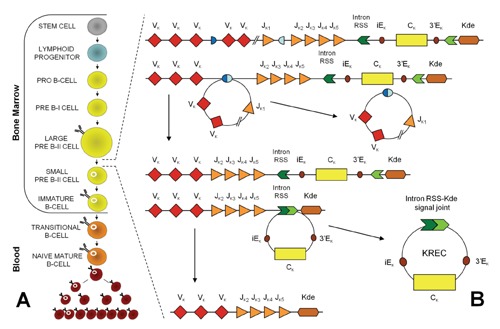Figure 2.

B-cell differentiation and K-deleting recombination excision circle formation. (A) B-cell development begins as lymphoid stem cells differentiate into progenitor B cells (pro-B cells), which are the earliest distinctive B-lineage cells. During the antigen-independent maturation phase, immune competent B cells expressing membrane IgM and IgD are generated in the bone marrow. Only approximately 10% of the potential B cells reach maturity and leave the bone marrow. Naïve B cells in the periphery die within a few days unless they encounter soluble protein antigen and activated Th cells. Once activated, B cells proliferate within secondary lymphoid organs. (B) B-cell differentiation from the stem-cell to the plasma-cell stages is characterised by Ig V(D)J rearrangement, somatic mutation and Ig class switching. The V(D)J recombination on the IGK locus results in a Vκ-Jκ coding joint. Subsequent rearrangement between the intronRSS and the Kde element can render the IGK allele non-functional by deleting the IGKC exon and the enhancers. Consequently, the coding joint precludes any further rearrangements in the IGK locus and, therefore, remains present in the genome, whereas an intronRSS-Kde signal joint is formed on the KREC.
